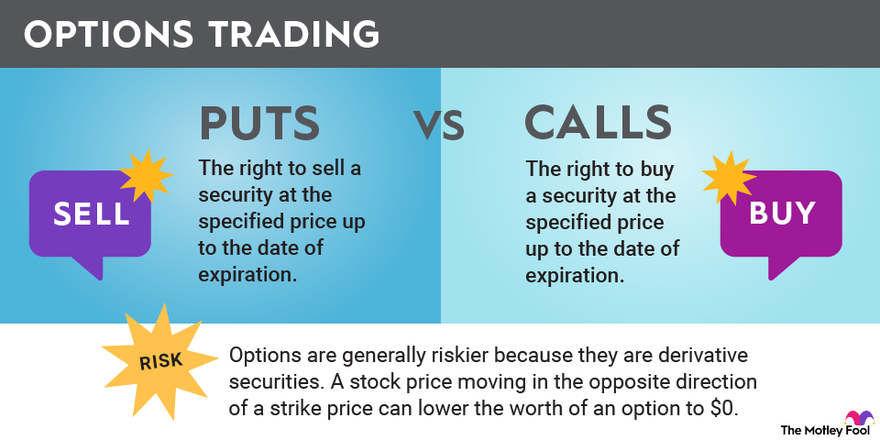Have you ever wished you could predict the future of the stock market? While time travel is still a work of science fiction, options trading offers a unique and potentially lucrative way to navigate the complexities of the financial landscape. It allows investors to take calculated risks, embrace uncertainty, and potentially reap significant rewards, all while managing their exposure to market fluctuations. But understanding this intricate world requires more than a simple Google search – it demands a deep dive into the intricacies of options contracts, strategies, and risks.

Image: www.reddit.com
This comprehensive guide will serve as your roadmap to navigate the world of options trading. We’ll demystify its core concepts, explore different strategies, examine potential risks, and ultimately empower you to make informed decisions. Whether you’re an experienced investor looking to expand your portfolio or a beginner eager to explore new avenues, this article will equip you with the knowledge to embark on your options trading journey with confidence.
What Are Options?
In essence, options are contracts that give the buyer the *right*, but not the *obligation*, to buy or sell an underlying asset at a predetermined price (the strike price) on or before a specified date (the expiration date). These contracts are traded on exchanges, much like stocks, and their value fluctuates based on factors like the price of the underlying asset, time to expiration, and market volatility.
There are two main types of options:
- Calls: Give the holder the right to *buy* the underlying asset at the strike price. Call buyers are bullish, anticipating a price increase.
- Puts: Give the holder the right to *sell* the underlying asset at the strike price. Put buyers are bearish, anticipating a price decrease.
Why Trade Options?
Options trading offers several advantages over traditional stock trading, attracting investors with diverse financial goals:
- Leverage: Options contracts allow investors to control larger positions with smaller investments. This can amplify both gains and losses, making them suitable for investors seeking high potential returns.
- Limited Risk: Unlike stocks, where losses can theoretically be unlimited, options have inherent limitations. The maximum loss on a long option position is typically the premium paid.
- Flexibility: Options offer various strategies to profit from market movements, including hedging against losses, generating income, or speculating on price direction.
Understanding Option Pricing
The price of an option is referred to as the **premium**. Several factors influence its value, including:
- Underlying Asset Price: The price of the underlying asset directly affects the value of the option. If the underlying asset price is above the strike price, call options will be more valuable. Conversely, if the underlying asset price is below the strike price, put options will be more valuable.
- Time to Expiration: The value of an option generally increases as it approaches its expiration date, as the probability of the asset price moving in the desired direction increases. This is known as **time decay**.
- Volatility: High volatility in the underlying asset price increases the probability of large price movements, making options more valuable. Conversely, low volatility makes options less valuable.
- Interest Rates: Interest rates can influence option pricing, particularly for long-term options. Rising interest rates generally decrease the value of call options and increase the value of put options.

Image: www.fool.com
Common Options Trading Strategies
Options trading encompasses a wide range of strategies, each with its own risk profile and potential rewards.
1. **Covered Calls**
Covered calls involve selling call options on a stock that you already own. This strategy generates income through the premium received from the option sale, while limiting potential upside gains on the underlying stock. Covered calls are typically used by investors who are bullish on a stock but want to generate income from their holdings.
2. **Cash-Secured Puts**
Cash-secured puts involve selling put options and holding an equivalent amount of cash in the margin account to cover the potential obligation to purchase the underlying stock. This strategy is similar to covered calls but generates income by selling put options instead of call options. Cash-secured puts are suitable for investors who are bullish on a stock and want to generate income while potentially acquiring shares at a lower price.
3. **Protective Puts**
Protective puts involve buying put options on a stock you own to protect your investment from potential price declines. This strategy is a form of insurance for your stock position, ensuring that you can sell your shares at a predetermined price even if the stock price falls significantly. Protective puts are suitable for investors who want to limit their downside risk while maintaining potential upside gains.
4. **Bull Call Spread**
A bull call spread involves buying a call option with a lower strike price and selling a call option with a higher strike price. Both options have the same expiration date. This strategy limits potential loss to the difference between the premium paid and received, while profiting if the stock price rises. Bull call spreads are suitable for those who anticipate moderate price increases in the underlying stock.
5. **Bear Put Spread**
A bear put spread involves buying a put option with a lower strike price and selling a put option with a higher strike price, both with the same expiration date. This strategy limits potential loss to the difference between the premium paid and received, while profiting if the stock price falls. Bear put spreads are suitable for investors who anticipate moderate price declines in the underlying stock.
Understanding the Risks
As with any financial instrument, options trading comes with inherent risks. It’s crucial to understand and manage these risks before engaging in any options strategy:
- Time Decay: Options lose value as they approach their expiration date. This can be significant for longer-term options, especially if the underlying asset price doesn’t move as anticipated.
- Unlimited Risk: In theory, losses on options positions are unlimited, especially for those who sell options (writing options). This is because the price of the underlying asset can move significantly in the opposite direction of your bet, potentially exceeding the premium received.
- Volatility: High volatility can be beneficial or detrimental to options trading. While it can increase potential gains, it also amplifies risk. High volatility can cause rapid price fluctuations, making it difficult to manage positions and potentially leading to large losses.
Important Considerations
Before venturing into options trading, it’s essential to consider the following:
- Risk Tolerance: Options trading involves higher risk than traditional stock investing. It’s essential to assess your risk appetite and only invest an amount you’re comfortable losing.
- Trading Experience: Options trading requires a thorough understanding of market dynamics, pricing, and strategies. It’s advisable to gain experience with traditional stock trading before delving into options.
- Education: Options trading is complex, and it’s crucial to educate yourself thoroughly before making any trades. Numerous online resources, books, and courses can help you develop your knowledge and skills.
Trading Option
Conclusion
Options trading offers exciting opportunities to leverage market movements, manage risk, and potentially enhance returns. By understanding the fundamentals, exploring various strategies, and carefully managing risks, you can navigate this complex but rewarding world of financial instruments. Remember, options trading isn’t a get-rich-quick scheme. It requires discipline, patience, and a comprehensive understanding of the market. Always conduct thorough research, seek guidance from experienced professionals, and prioritize risk management to ensure a safe and potentially successful options trading journey.






